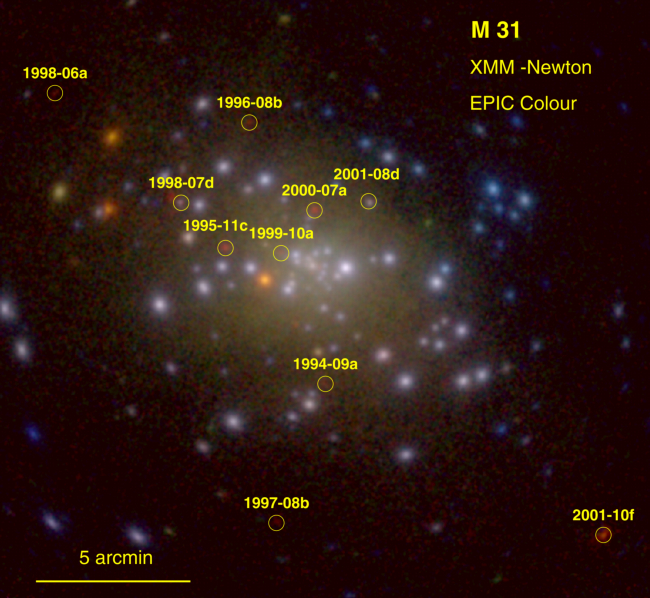
 Credit: Wolfgang Pietsch, Max Planck Institut für Extraterrestrische Physik; ESA
Credit: Wolfgang Pietsch, Max Planck Institut für Extraterrestrische Physik; ESA
Die Fast, Die Slow
Novae, or "new stars", are famous astronomical misnomers, old condensed white dwarf stars which strip matter from a companion star, heat it to enormous temperatures and burn it explosively via surface nuclear fusion. One of the few direct views physicists have of thermonuclear fusion, by the way. Variable X-ray emission from this process provides important information about burning rates, densities, and temperatures. For this reason astronomers trained a powerful X-ray telescope, XMM-Newton, on a nearby galaxy M31 (better known as the Andromeda galaxy) to measure when and how recent novae shine in X-rays. The image above shows the XMM-Newton image of the central region of M31, where color stands for X-ray energy: blue for high energy X-rays, green for medium energy and red for low energy X-rays. Positions of optical novae are labelled and circled. And they found something never seen before: a new class of novae which quickly brighten in X-rays then fade away in just a few months. On the other hand, the XMM-Newton studies also showed that some novae generate X-rays for a decade or more after their initial explosion. What accounts for the difference?
<
HEA Dictionary ● Archive
● Search HEAPOW
● Other Languages
● HEAPOW on Facebook
● Download all Images
● Education ● HEAD
>
Each week the HEASARC
brings you new, exciting and beautiful images from X-ray and Gamma ray
astronomy. Check back each week and be sure to check out the HEAPOW archive!
Page Author: Dr. Michael F. Corcoran
Last modified Tuesday, 27-Feb-2024 10:06:44 EST


